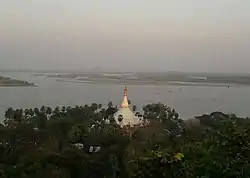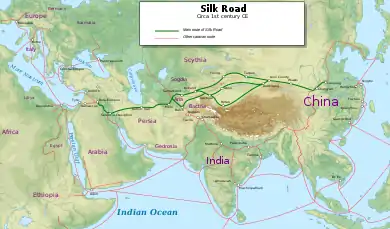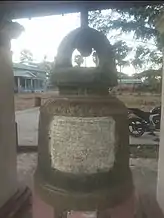Mottama
Mottama (Burmese: မုတ္တမမြို့, pronounced [moʊʔtəma̰ mjo̰]; Mon: မိုဟ် တၟံ, [mùh mɔˀ]; formerly Martaban) is a small town in the Thaton district of Mon State, Myanmar. Located on the west bank of the Thanlwin river (Salween), on the opposite side of Mawlamyaing, Mottama was the capital of the Martaban Kingdom (later known as Hanthawaddy Kingdom) from 1287 to 1364, and an entrepôt of international repute until the mid-16th century.
Mottama
မုတ္တမ မိုဟ်တၟံ | |
|---|---|
Town | |
 | |
 Mottama Location in Burma | |
| Coordinates: 16°32′N 97°36′E | |
| Country | |
| State | |
| District | Thaton District |
| Population | |
| • Ethnicities | Mon Burman Karen |
| • Religions | Theravada Buddhism |
| Time zone | UTC+6:30 (MST) |
Etymology
"Mottama" derives from the Mon language term "Mumaw" (Mon: မိုဟ် တၟံ; /mùh mɔˀ/), which means "rocky spur."[1][2]
History
Prior to 15th century

Between 2nd-century BCE and 15th-century CE, Martaban was an important trading port in the historic Maritime Silk Road connected the East and West, and Martaban storage jars were imported through this maritime road.
The earliest evidence of the existence of Martaban in Myanmar history was revealed in an inscription erected by King Sithu II of Pagan (Bagan) Empire in 1176.[3]
In the 13th century, Martaban was a southern provincial capital in the Pagan Empire. After Pagan's collapse in 1287, King Wareru founded the Martaban Kingdom based out of Martaban.[4]:205–206 The city was the capital of a Mon-speaking kingdom from 1287 to 1364. Nominally it was a vassal state of the Thai Sukhothai Kingdom until 1314.[5] From 1369 onwards, the Hanthawaddy kings ruled the kingdom from Bago (Pegu).[6] From 1364 to 1388, Martaban was under the de facto independent rule of Byattaba. In 1388, King Razadarit reconquered the city.[7] Though it was no longer the capital, the city remained an important trading port from the 14th century to the early 16th century.[8]

16th to 19th centuries
In 1541, King Tabinshwehti of Taungoo captured the fortified city, and utterly destroyed it, forever relegating it back to a backwater. From the 16th to the 19th centuries, Martaban was a strategic spot in a series of wars fought between Burma and Siam.
Colonial Period
Martaban was captured by the British in the First Anglo-Burmese War of 1824–1826, but returned to Burmese administration after the war. It became the border town however as the entire Tenasserim coast from Mawlamyaing down became British territory. The town became part of British Lower Burma after the Second Anglo-Burmese War of 1852.
Geography
The Salween River flows through the town into the Bay of Martaban.
Transport
Mottama was the terminus of the road and the railroad from Yangon, where the Thanlwin empties into the Gulf of Martaban in the Andaman Sea. Today Mawlamyaing Bridge has laid down a link from Mottama to Mawlamyaing and other city in the south Ye.
Notes
- Shorto, H.L. (1962). Dictionary of Modern Spoken Mon. Oxford University Press.
- Tun, Than (1988). "Observations on the Translation and Annotation of the Royal Orders Of Burma". Crossroads: An Interdisciplinary Journal of Southeast Asian Studies. 4 (1): 91–99. JSTOR 40860260.
- Aung-Thwin, Michael (2005). The mists of Rāmañña: The Legend that was Lower Burma (illustrated ed.). Honolulu: University of Hawai'i Press. ISBN 9780824828868.
- Coedès, George (1968). Walter F. Vella (ed.). The Indianized States of south-east Asia. trans.Susan Brown Cowing. University of Hawaii Press. ISBN 978-0-8248-0368-1.
- Mukherjee, Rila (2011), Pelagic Passageways: The Northern Bay of Bengal Before Colonialism, Primus Books, p. 212
- Harvey 1925: 368
- Fernquest 2006: 7–8
- Myint-U 2006: 67
References
- Jon Ferquest (Spring 2006). "Rajadhirat's Mask of Command: Military Leadership in Burma (c. 1384–1421)". SBBR. 4 (1): 7–8.
- Harvey, G. E. (1925). History of Burma: From the Earliest Times to 10 March 1824. London: Frank Cass & Co. Ltd.
- Myint-U, Thant (2006). The River of Lost Footsteps—Histories of Burma. Farrar, Straus and Giroux. ISBN 978-0-374-16342-6.
Mottama | ||
| Preceded by Bagan (Pagan) as Capital of Pagan Empire |
Capital of Martaban Kingdom 30 January 1287 – c. February 1364 |
Succeeded by Donwun |
